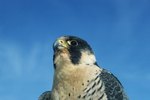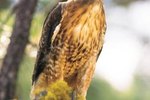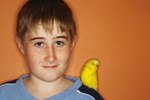By the time British ornithologist John Gould died in 1881, he was known around the world as the Bird Man. In 1847, Gould named North America's tiniest bird, calling it the Calliope hummingbird. Why Gould named the bird after the Greek muse of heroic poetry is unknown -- though Calliope hummingbirds make epic 9,000-mile round-trip flights each year in their quest to breed from the middle of April to the middle of July, heroic efforts indeed.
The Name Game
Look for the taxonomic name of the Calliope hummingbird and you'll discover it has two such names. Initially the Latin name for the bird was Stellula calliope; stellula meaning little star and reportedly referring to the brilliant, starlike magenta streaks under the male's chin. In 2008, McQuire and colleagues argued that the calliope hummingbird belonged in the genus Selasphorus. Consequently some resources list the taxonomic name for Calliope hummingbirds as Selasphorus calliope.
Smallest Birds
Calliope hummingbirds range in length from 2.75 to 3.25 inches. They winter in Mexico and breed in the mountainous areas of the Northwestern United States and Canada. Males have green heads and white chests. Splayed across the front of the males's chests are arrays of magenta feathers that appear like half starbursts. Females are slightly larger than males. Females and juveniles have green backs and crowns with buff-colored feathers on their chests and stomachs. Females' throats can have some red spotting.
Solitary Men
Hummingbirds do not flock like other birds. They live singular lives and come into contact other than coincidentally only during breeding season. Calliope hummingbirds have short beaks and short wings. When they fly, the wings create a sound reminiscent of bee buzzing. Males arrive at breeding grounds in middle April or early May to establish territory. Hummingbirds do not mate for life; males mate with several females during breeding season.
Single Moms
Hummingbirds have been on the move, showing up earlier in locations and in some cases leaving later. Trying to quantify the breeding season for these birds varies by state; as of 2013 data were in flux due to climate change. The Montana government website posts nesting counts for Calliope hummingbirds, although it is unclear how old the data are or how they were collected. Eggs are laid from late June to early July. However in Fortine, Montana, near the Canadian border, eggs were laid from June 5 to July 11. The earliest recorded egg hatching in Fortine was June 11. Female Calliope hummingbirds usually lay two eggs and incubate them alone for about two weeks. Moms build the nests, feed the babies and protect them until they fledge when they are about 3 weeks old.
References
- Whose Bird?; Bo Beolens and Michael Watkins
- Journal of Ornithology: A Higher Level Taxonomy for Hummingbirds
- Montana.gov: Montana Field Guides: Calliope Hummingbird - Selasphorus calliope
- Audubon: Birds: Calliope Hummingbird: Stellula Calliope
- AvianWeb: Calliope Hummingbirds
- Cornell Lab of Ornithology: Neotropical Birds: Range Map - Calliope Hummingbird Stellula Calliope
- American Birding Association: ABA Blog: #ABArare - Calliope Hummingbird - Manitoba
Resources
- Hummingbirds of North America: The Photographic Guide; Steve Howell
- The Complete Book of Hummingbirds; Tony Tilford
- The Condor: Display Behavior of Male Calliope Hummingbirds During the Breeding Season
- Louisiana Ornithological Society: Short Communication: Three Records of Calliope Hummingbird From Louisiana





